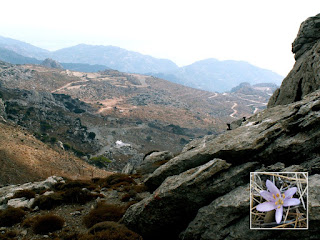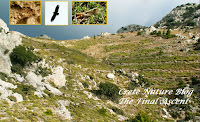Forgive
me if I break into song as we commence our walk into this gully but it’s such a
beautiful morning – Sweet painted lady,
seems it’s always been the same, getting paid for being laid, guess that’s the
name of the game - that’s better; nothing like a bit of Elton John to start
the day. OK that was not a bit like Elton John.
 |
| Painted Lady, Vanessa cardui and Red Admiral, Vanessa atalanta |
The reason for this sudden
burst of exuberance is the orange and brown butterflies that are accompanying
us, Painted Ladies, which we saw a couple of weeks back pollinating the ivy (Life in the Uplands). The
red and black butterflies that are also joining us are Red Admirals and the two
are closely related. The Painted Lady is Vanessa
cardui and the Red Admiral is Vanessa
atalanta. I find it intriguing that one should be named after a lady of the night and the other after a high
ranking naval officer, a sort of
lepidopteran equivalent of the actress and the bishop I suppose.
 |
| Italian Vipers Bugloss, Echium italicum |
Last week
we were chatting about Iron and how it travels from the rocks to our blood but
this week I want to have a little look at another chemical element, Calcium.
Take this knee high plant down here for instance called Pale Bugloss which
looks a bit like an artificial Christmas tree. If you look closely at the stiff
hairs on the leaves and stem (a characteristic of the borage family to which it
belongs) then you are looking at calcium in action, the element which gives
life its hard bits. In our case that means bones and teeth and it gives plants
the ability to stand erect.
| Snails of the Helicidae family |
Snails of
course, such as these of the Helicidae family which I’ve assembled on this bit
of limestone, use it for shell building. This is recycling in its purest form
as limestone, which is primarily calcium carbonate (calcium + carbon + oxygen),
is formed from the shells of marine molluscs. When the sea bed was lifted to
form these mountains, about 26 million ago, the calcium in the sea shells
formed these rocks and the land snails are now taking it back by rasping away
at the algae on the rocks and munching the plants that grow on them to make
their own shells. And so the elements go round. There are 94 naturally
occurring elements in all and nature re-uses most, if not all, of them in
continuous cycles.
 |
| Lichens |
Come on,
I’ve spotted a cave, or leastways a medium sized hole in the rocks, I suppose
one could call it a cavelet. Let’s explore it. Ooh, lichens. Look at this
doughnut shaped one up here. Lichens grow very slowly from the middle out. This
one is so old that the original ancestor has died and we’re looking at the
succeeding generations. And this one at the back here seems to be almost
glowing green. Unlike plants, lichens have no waxy cuticles or pores that they
can close to keep out unwanted substances so they are very useful for
monitoring air pollution. If you take a piece of lichen, dissolve it in acid
and analyse the resultant liquid you can determine the types and amounts of
elements that shouldn’t be there. In 2015 for instance the discovery of heavy
metals in the lichens of Washington State in the US was traced to a zinc and
lead smelter across the border in Canada. [1]
| Jumping Spider of the Salticidae family |
Ever get
the feeling that you are being watched? There’s a little jumping spider on that
rock down there and I think that he’s got his eye on us, or to be more precise,
at least six of his eight eyes on us. Why so many? Recent research has found that
the front pair are for sharp, colour vision including ultra violet. The next
pair, the anterior lateral eyes, are detailed motion sensors. If you cover only
the main eyes the spider will back away from an approaching object but if you
only cover the anterior lateral eyes it won’t. The other eyes are thought to be
less detailed motion sensors giving the spider a wider field of awareness but
research continues on that score.[2]
This
seems a nice place to stop and admire the scenery so we’ll continue on down the
gully next week and see what else we can find.
The Extra Bit
It’s that
time of year again when the oranges are ripening and it’s time to make some marmalade.
When I mentioned this last year so many people asked me for a recipe that this
year I’ve decided to publish a supplementary blog post complete with recipe
card and a cut out label for your jars. So if you’d like to follow
me to the kitchen I’ll show you a simple way to make delicious marmalade that
keeps for a couple of years (if you haven’t eaten it all by then)…Steve's Simple Marmalade
***********************************************************************************
LINKS:
Naturalists
(the facebook page that accompanies this blog)
See detailed pictures at
http://www.inaturalist.org/login (search - people-stevedaniels-observations)


















